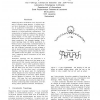Free Online Productivity Tools
i2Speak
i2Symbol
i2OCR
iTex2Img
iWeb2Print
iWeb2Shot
i2Type
iPdf2Split
iPdf2Merge
i2Bopomofo
i2Arabic
i2Style
i2Image
i2PDF
iLatex2Rtf
Sci2ools
IJCAI
1989
1989
Reasoning about Kinematic Topology
t ion which is much more abstract than a place vocabulary, the kinematic topology. Kinematic topology does not define qualitative inference rules, but provides a characterization of the topology of legal configurations. For example, the kinematic topology of a pair of gears is one or several doubly connected regions, whose shape in configuration space indicates the relative speeds of the two gears. For many applications, reasoning about kinematics at this level is sufficient. Kinematic topology can be computed in a purely qualitative manner and thus gives an existence proof that a purely qualitative kinematics is possible. Like in other qualitative reasoning applications, the qualitative computation has the effect that the result is almost always ambiguous. On the other hand, a kinematic topology can be given even for mechanisms whose designs are only imprecise sketches, and can be generalized to arbitrary object shapes, several degrees of freedom, and three dimensions. We hope that su...
| Added | 07 Nov 2010 |
| Updated | 07 Nov 2010 |
| Type | Conference |
| Year | 1989 |
| Where | IJCAI |
| Authors | Boi Faltings, Emmanuel Baechler, J. Primus |
Comments (0)

